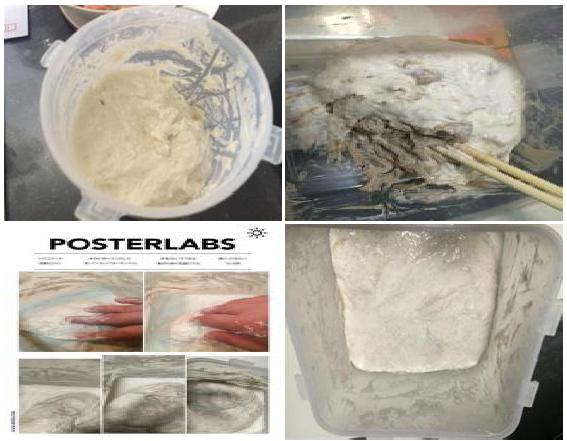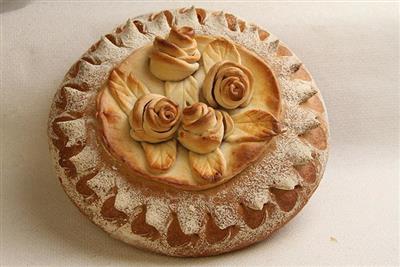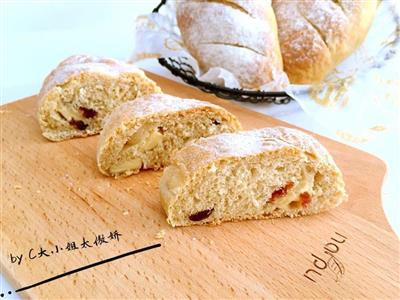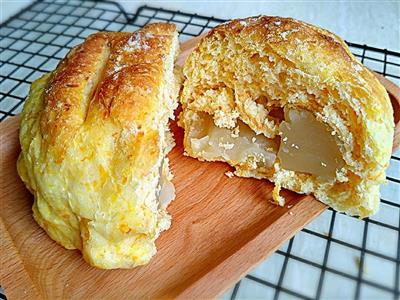36 hours of natural Ciabatta Shabada bread

It's natural to use 36 hours of natural yeast dough to make Shapada slippers.Sharbada, like the legal stick, also requires many holes, thin skin, crisp shell, and internal moisture, so the dough also requires less kneading and more folding, and the main fermentation is sufficient.Because there are so many holes, the dough needs to be so wet, so although only 10% of the coarse grain is in the dough, 85% of the water is added, and after fermentation it is literally a bag of water bubbles! But although the process does not torture people, the perfect holes in the finished product make people feel worth it.
WHAT YOU NEED
Ingredients
213 grams of high starch flour175 grams of ice water50 grams of rye natural yeast (100% water powder)High starch flour natural yeast (100% water powder) 25 grams4 grams of salt
How TO MADE 36 hours of natural Ciabatta Shabada bread
Steps 1 to 4

1. Mix high flour and ice water, stir into a lump, rub it by hand, refrigerate and soak overnight, 8 to 12 hours.
2. Add salt and two natural yeasts and stir until the dough is basically even.
3. Since the texture of natural yeast is closer to dough, it is easier to knead evenly than the previous version with instant yeast.
4. It doesn't matter if it's uneven after stirring, it's perfectly uniform during the folding process below.
Steps 5 to 8

5. It is fermented at room temperature (25°C) for 3 hours.
6. Fold at 30, 60, 90, 120, 150 minutes (European wrapping method, the whole dough is gathered from the edge to the center), a total of 5 times.
7. The dough is very sticky and wet, and the movement is slow.
8. The number of folds should be adjusted according to the strength of your dough.
Steps 9 to 12

9. The dough will be a little bigger, but far from twice as big.
10. Continue to refrigerate for 24 hours.
11. Take out the dough that has been refrigerated for 24 hours, and when you take it out, the dough grows to twice its original size. If it doesn't grow that much, keep fermenting at room temperature to about twice its original size, and the dough will have a lot of bubbles.
12. Here it is necessary to decide whether to continue fermenting at room temperature and how long to ferment depending on the condition of the dough.
13. Depending on my type of yeast, room temperature, refrigerator temperature, etc., it usually takes about one to two hours of room temperature fermentation after the dough is removed from the refrigerator, but it is absolutely not general.
14. Divided into two parts, it is fermented on baking paper or oil cloth until it is very light and foamy, at 25 degrees for about 60 to 70 minutes.
15. At the same time, the oven is preheated together with the stone board and the grill to 250 degrees, which takes about 40 minutes to an hour.
16. Before entering the oven, turn the dough upside down and place it on a baking tray with baking paper.
17. (Otherwise, the bubbles will float to the surface, but this step is not without danger, the dough is very sticky and extremely difficult to operate)
18. Put some boiling water in the pan and close the door.
19. Take the dough, open the door, transfer it to the stone plate along with the baking paper, pour another glass of hot water into the baking tray with water below, close the door.
20. The baking temperature is reduced to 230 degrees, baked for 10 minutes, take out the baking paper and the baking tray with water, and baked for about 15 to 20 minutes.
21. Baked bread, well inflated, taken out and cooled
22. Cut the hole, the hole, the hole, the hole, the hole.
23. It's beautiful out there.
REACTION RECIPES
- Black tea and crackers
- Baby health finger biscuits
- This is a Doraemon cookie.
- Peanut butter
- Onion soup and biscuits
- This is Margaret.
- Caramel and almond cookies
- Butter and cheese cookies
- Cranberry cookies
- Chocolate chip cookies
- Chocolate cherry blossom cookies
- Cranberry cookies
- Chocolate bean cookies
- Sugar cream cookies
- Blueberry cookies
MOST POPULAR RECIPES
- Onion flower bread
- Raspberry caterpillar bread
- The Blue Fairy
- The children's favorite ultra-soft meat and sesame seeds
- It's not like I'm going to die.
- Whole wheat bread
- Fruit bread
- Japanese dairy bread
- Pumpkin toast with two colors
- Thousands of slices of bread
- Flower toast
- Cheese bread
- Carrot black sesame nut bread
- Making classic old-fashioned bread
- Honey forks and bags

 DESSERTS
DESSERTS  BAKING
BAKING  MAIN DISHES
MAIN DISHES  SNACKS
SNACKS  CHINESE FOOD
CHINESE FOOD  HOME
HOME






